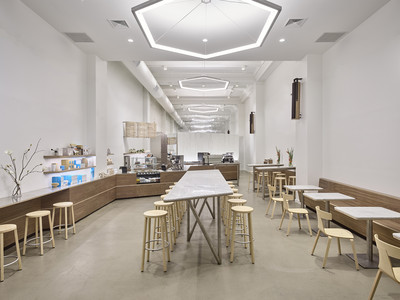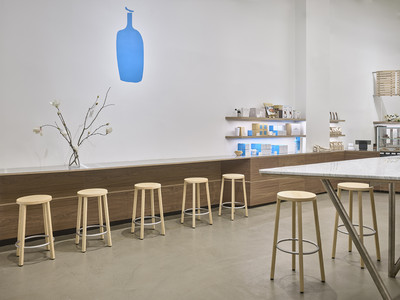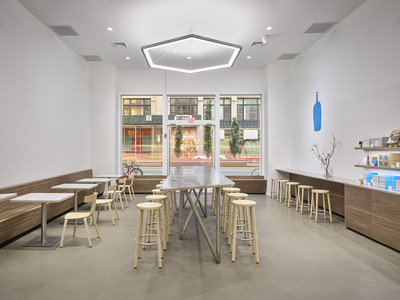Blue Bottle Coffee, Gramercy Park by Lincoln Lighthill Architect

When west-coast architect Lincoln Lighthill was approached by pioneering coffee brand Blue Bottle Coffee to design its latest New York City location, he looked to blend aspects of the brand’s progressive attitude to coffee roasting with references to the history of Manhattan’s iconic café culture. In the following interview, Lighthill explains how he managed to balance modern style and a nod to tradition by combining a carefully chosen material palette with innovative joinery elements and furniture from PLANK.

Lincoln, you’ve worked on several cafés for Blue Bottle Coffee in the past. With this project, how did you go about translating the brand’s values into a space that also references its Manhattan location?
With every café we create for Blue Bottle Coffee, we’re always trying to find a new and unique interpretation of their style that reflects the local culture, as well as the care and craft of making high-quality coffee. In that sense we’re looking to advance café design in the same way that Blue Bottle Coffee is advancing the art of coffee making. For this project, we took the rich palette of the local cafés with their dark, wood paneling and grand, ornate interiors as a starting point. Blue Bottle Coffee’s coffee represents a modern understanding of the craft [of coffee roasting] and so we created a modern interpretation of existing cafés by mixing traditional elements with Blue Bottle Coffee’s aesthetic.
What are the most unique or innovative features of the café’s design?
The angled, zig-zag shape of the service bar, and the way the furnishings respond to this, are the most radical departure from traditional cafés. This concept responds to the way people flow through a space, rather than forcing them into rigid, rectilinear zones that make it more difficult to navigate a crowded café. We also wanted to exaggerate the grand proportions of the space in a playful way, which we did by placing mirrors at both ends of the room, creating an endless, hall of mirrors sense of grandeur.
Why did you choose PLANK furniture for this project and what do these products add to the interior scheme?
The material palette combines dark wood – in this case walnut paneling – with lighter, blond wood tones to tie in with the Blue Bottle Coffee aesthetic and inject more light and airiness into the space. The exposed, blond edges of the walnut veneer plywood tie in with the blond PLANK furniture and set it apart from the fairly dark and gloomy traditional cafés. The modern forms of the furniture also reinforce that this is not only a modern space, but one that aligns with Blue Bottle Coffee’s core aesthetic.
Can you talk specifically about why you chose the REMO chairs and BLOCCO stools?
Similar to the idea that the zig-zag service bar better accommodates the customer flow, the curved, wrapping forms of the REMO chairs also suggest a sense of modern accommodation, unbound by tradition, or the limitations of traditional fabrication techniques. The detailing of the products also supports the idea that the architectural design is a reflection of the highly precise and detailed way in which every cup of Blue Bottle coffee is prepared.

How do you think hospitality design might evolve in the coming months or years as a result of the ongoing Covid-19 crisis?
The tension between designing for right now versus designing for the future feels like the central design challenge of this moment. No one wants to design spaces as if we will be exactly where we are, forever. That would suggest a highly segregated and even lonely take on how we interact (or don’t interact!) in public spaces, full of barriers and separations. I think the challenge is to design spaces that give us the safety we need now in order to continue to live in the world, and the flexibility to return to a less constrained way of living and interacting in the future. Exactly how we do this is different for every project typology, and something that we are actively working on in everything that we’re involved with right now.
What are your big hopes and ambitions for your studio in the coming years?
I hope that the scope, scale, and sustainability of our work will continue to grow and evolve. I’d also like to have more opportunities to work with companies like PLANK which are, like us, trying to push the boundaries of design and creativity amid the ever-expanding challenges we all face as an industry and a civilization.
UPDATES
Receive product updates and inspirations: